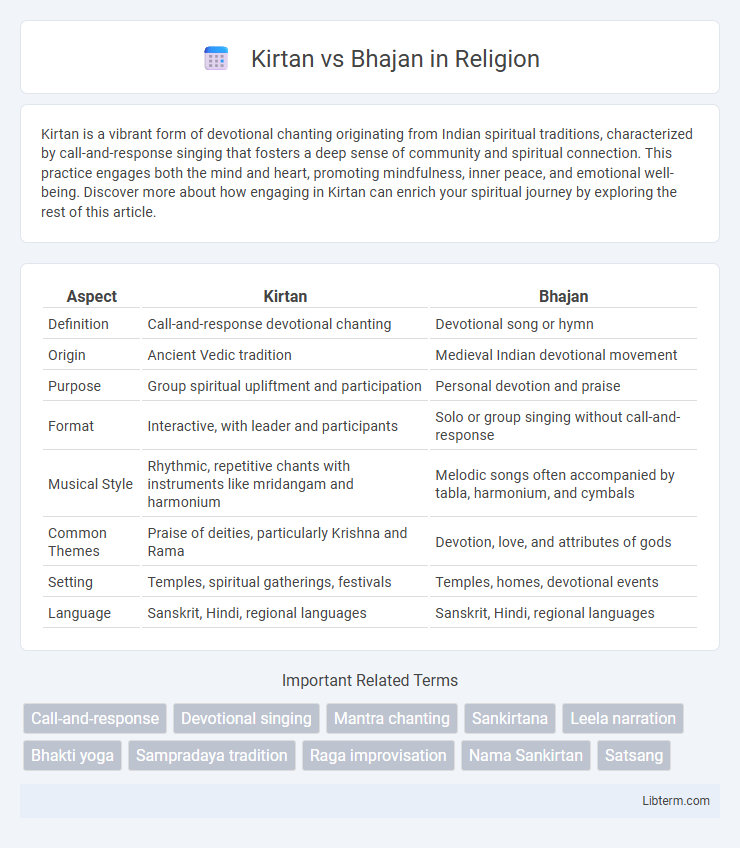Kirtan is a vibrant form of devotional chanting originating from Indian spiritual traditions, characterized by call-and-response singing that fosters a deep sense of community and spiritual connection. This practice engages both the mind and heart, promoting mindfulness, inner peace, and emotional well-being. Discover more about how engaging in Kirtan can enrich your spiritual journey by exploring the rest of this article.
Table of Comparison
| Aspect | Kirtan | Bhajan |
|---|---|---|
| Definition | Call-and-response devotional chanting | Devotional song or hymn |
| Origin | Ancient Vedic tradition | Medieval Indian devotional movement |
| Purpose | Group spiritual upliftment and participation | Personal devotion and praise |
| Format | Interactive, with leader and participants | Solo or group singing without call-and-response |
| Musical Style | Rhythmic, repetitive chants with instruments like mridangam and harmonium | Melodic songs often accompanied by tabla, harmonium, and cymbals |
| Common Themes | Praise of deities, particularly Krishna and Rama | Devotion, love, and attributes of gods |
| Setting | Temples, spiritual gatherings, festivals | Temples, homes, devotional events |
| Language | Sanskrit, Hindi, regional languages | Sanskrit, Hindi, regional languages |
Introduction to Kirtan and Bhajan
Kirtan and Bhajan are traditional Indian devotional music forms that focus on spiritual expression and community participation. Kirtan typically involves call-and-response chanting of mantras or divine names accompanied by musical instruments, creating an immersive, interactive experience. Bhajan consists of lyrical hymns and songs praising deities, often performed in a melodic, contemplative style aimed at fostering devotion and inner reflection.
Historical Origins and Evolution
Kirtan and Bhajan both originate from ancient Indian devotional traditions, with Kirtan rooted in the Vedic era as a call-and-response chanting practice aimed at communal worship. Bhajan evolved during the Bhakti movement between the 7th and 17th centuries, emphasizing personal devotion through lyrical songs dedicated to deities. Over time, Kirtan retained its structured, repetitive format promoting collective participation, while Bhajan diversified into various musical styles reflecting regional and cultural influences across India.
Core Philosophical Differences
Kirtan emphasizes repetitive call-and-response chanting of divine names to invoke a collective spiritual experience, fostering direct emotional connection and bhakti (devotion) towards a personal deity. Bhajan, rooted in devotional poetry and melodic expressions, focuses on narrating divine qualities and spiritual stories, encouraging individual reflection and meditation on spiritual teachings. The core philosophical difference lies in Kirtan's communal invocation of divine presence versus Bhajan's contemplative celebration of divine attributes.
Musical Structure and Elements
Kirtan features a call-and-response structure emphasizing rhythmic repetition and melodic improvisation, often led by a lead singer and supported by instruments like harmonium, tabla, and cymbals. Bhajan typically consists of a more straightforward, melodic form with strophic verses and a steady tempo, using instruments such as the tanpura, dholak, and flute to create a devotional atmosphere. Both share elements of spiritual expression but differ in musical complexity and participatory engagement.
Performance Style and Atmosphere
Kirtan features a call-and-response performance style that encourages active participation from the audience, creating a dynamic and immersive spiritual atmosphere. Bhajan typically involves solo or group singing with a more melodic and contemplative approach, fostering a serene and devotional ambiance. The energetic rhythm of Kirtan contrasts with the soulful harmony of Bhajan, shaping distinct experiential environments in Hindu devotional practices.
Role in Spiritual Practices
Kirtan and Bhajan play distinct roles in spiritual practices, with Kirtan emphasizing call-and-response chanting that fosters collective devotion and heightened states of spiritual ecstasy, often led by a musician or spiritual leader. Bhajan typically involves more free-form singing of devotional hymns, allowing individuals to express personal devotion and deepen their connection to the divine through lyrical storytelling. Both practices serve to cultivate mindfulness, reinforce religious teachings, and facilitate communal worship within Hinduism and other Indian spiritual traditions.
Key Instruments Used
Kirtan and Bhajan both prominently feature traditional Indian instruments such as the harmonium, tabla, and dholak, which create rhythmic and melodic foundations. Kirtan often incorporates the kartal (hand cymbals) and manjira for enhanced percussive elements that facilitate call-and-response singing. Bhajan typically emphasizes softer instruments like the veena and flute, producing a more devotional and meditative sound.
Social and Cultural Significance
Kirtan and Bhajan serve as vital expressions of communal devotion and spiritual unity in Indian culture, fostering deep social cohesion through collective participation in temples and gatherings. Kirtan emphasizes call-and-response chanting that promotes interactive engagement, often accompanied by musical instruments, enhancing group involvement and emotional connection. Bhajan, characterized by lyrical singing of devotional songs, nurtures personal devotion while reinforcing shared cultural values and religious narratives across diverse communities.
Popular Examples and Exponents
Kirtan and Bhajan, both integral to Indian devotional music, showcase distinct styles with popular exponents like Sant Ravidas and Tulsidas for Bhajans, and Sant Tukaram and Meera Bai for Kirtans. Bhajans typically feature simple lyrical compositions praising deities, performed by artists such as Jagjit Singh and Anup Jalota, while Kirtans involve call-and-response chanting, popularized by groups like the Hare Krishna movement and performers like Krishna Das. The diverse repertoire in both forms highlights their cultural significance, with Kirtans emphasizing communal participation and Bhajans focusing on melodic storytelling.
Choosing Between Kirtan and Bhajan
Choosing between Kirtan and Bhajan depends on the desired spiritual experience and community involvement. Kirtan emphasizes call-and-response chanting with repetitive mantras that foster group participation and collective energy, making it ideal for immersive devotional gatherings. Bhajan typically involves melodic singing of hymns with simpler rhythms, focusing more on personal reflection and lyrical devotion, suitable for intimate or contemplative settings.
Kirtan Infographic

 libterm.com
libterm.com